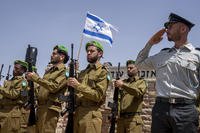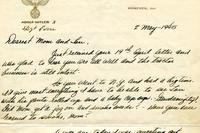Colleague Ward Carroll is embedded with U.S troops in Afghanistan.
BAGRAM AIRFIELD, AFGHANISTAN – Although the bureau numbers on the fuselages of Marine Electronic Attack Squadron 2's EA-6B Prowlers tell of jets harkening from the Cold War, the venerable jammers have found a new and vital niche in the counterinsurgency of Afghanistan.
The Prowler was originally designed to fight complex integrated air defense systems like those designed by the former Soviet Union. Through the use of powerful pods slung under each wing, the airplane would "jam" ground-based radars, blinding the enemy and paving the way for attack jets and fighters to hit their targets.
And in the event a SAM site did fire its missiles, the Prowler would launch high-speed anti radiation, or "HARM," missiles to wipe out the air defense site before it could shoot down any of the American airplanes.
But the Taliban have no complex Soviet-style SAM systems; and the closest thing they have to an integrated air defense is when they coordinate their RPGs with their AK-47s. So what are the Marine Prowlers doing in Afghanistan?
"The EA-6 has always been predominantly non-kinetic type of asset," said Marine Maj. Robert "Kid" Kudelko, VMAQ-2's operations officer. "And in a fight that's increasingly non-kinetic in terms of ‘hearts and minds' – not wanting to cause collateral damage – we bring another dimension."
The squadron -– that goes by the official name of "Death Jesters" while favoring the classic Playboy magazine bunny as its logo on patches and the jets' tails –- is about a month into a six-month rotation here. They have five airplanes with them, although one of those jets has been "cannibalized" for parts since it severely damaged its landing gear two weeks into the deployment.
The four remaining Prowlers are used to fly an average of four sorties a day in support of coalition forces. Those sorties can last anywhere from two to six hours as long as tankers are available to keep the airplanes airborne. The squadron has a roster of nine pilots and 18 electronic countermeasures officers – "ECMOs" – to carry out those missions. (Each Prowler carries one pilot and three ECMOs.)
The squadron usually gets its missions three days ahead of time, with units on the ground submitting a Joint Tactical Air Support Request asking for some form of electronic warfare – not platform specific.
"[The coalition] has EC-130s, EP-3s, Rivet Joints, MC-12s," Kudelko said. "But if somebody wants some sort of offensive kinetic electronic warfare capability, if jamming is required, we're pretty much the only game in town."
While hesitant to discuss details around the highly classified EW missions, Kudelko explained that the war in Afghanistan is a lot more dynamic than the war in Iraq was for the jammers. He also said those asking for his planes are a lot smarter about the Prowler's capabilities.
"Their mission success revolves around their knowledge of how much we can bring to the non-kinetic fight," he said. "Basically, if the mission involves the electronic spectrum, we can find some means to influence it. The idea is to leverage what we can attack with what the other [electronic warfare platforms] can listen to, and what the guys on the ground desire."
In terms of supporting offensive ground operations Kudelko said, "Our role is to open a doorway by denying early warning and denying targeting."
When asked whether that meant jamming radio transmissions or shutting down television signals, for example, the Kudelko demurred: "There are various things they utilize that we can exploit."
That means if the coalition commanders on the ground want to keep the enemy from talking to one another, the Prowler can help. Kudelko also mentioned that his squadron was starting to coordinate better with the 4th Expeditionary Reconnaissance Squadron, one of the outfits tasked with the passive "listening" mission using the MC-12 Liberty, a highly-modified King Air.
"They probably have better situational awareness than anybody else at times," Kudelko explained "If I'm talking to them I can make sure I'm not jamming while they're trying to listen to something."
Kudelko made no mention of a counter-IED mission for the Prowlers. While that mission was a documented part of the EA-6's role during the Iraq War, more rudimentary triggering devices –- pressure plates and hard wire connections instead of electronically commanded detonators -– have mitigated the Prowlers ability to be a "route clearance" platform in Afghanistan.
Because of wear on the airframes, Prowler pilots are only allowed to pull 4 Gs during tactical maneuvers, which is 2.5 Gs less than the airplane was authorized originally. And while maintainers deal with a lot of issues newer platforms don't face, for the most part those who fix the jets are pleased with how the jets are holding up.
Gunnery Sgt. Josh Wilson, the airframes division chief with VMAQ-2, said he's been pleasantly surprised how the airplanes have stayed operational and how the rugged conditions here haven't adversely affected them. Squadron officials in maintenance control said the planes have averaged an 80 percent "fully mission capable rate" during their short time here – a number they consider good in light of the Prowlers' years of service.
And although the EA-6Bs generally fly too high to be threatened by RPGs or small arms fire, the Death Jesters got a stark reminder that they are operating in a war zone a few days ago when insurgents attempted to breach Bagram's perimeter during a bold, early morning assault.
A group of insurgents tried to cut through the wire adjacent to the squadron's barracks. A couple of alert enlisted Marines were wounded by a hand grenade after they engaged the infiltrators, Kudelko said.
"After the attack, we built our place into even more of a fortress," Kudelko said.
The insurgents were quickly neutralized; the Marines are now convalescing stateside, expected to make a full recovery.








